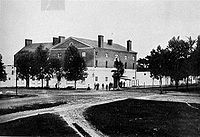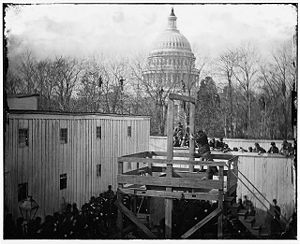
Old Capitol Prison
Encyclopedia

Washington, D.C.
Washington, D.C., formally the District of Columbia and commonly referred to as Washington, "the District", or simply D.C., is the capital of the United States. On July 16, 1790, the United States Congress approved the creation of a permanent national capital as permitted by the U.S. Constitution....
, served as temporary Capitol of the United States from 1815 to 1825, and became the Old Capitol Prison during the American Civil War
American Civil War
The American Civil War was a civil war fought in the United States of America. In response to the election of Abraham Lincoln as President of the United States, 11 southern slave states declared their secession from the United States and formed the Confederate States of America ; the other 25...
. Razed in 1929, its site is now occupied by the U.S. Supreme Court building.
Site history
The site, as with most of Capitol Hill, was part of Jenkins Hill and was acquired from the Carroll family to accommodate the U.S. Capitol. Located at 1st and A streets NE in Washington, D.C., on the eastern slope of Capitol Hill, the site's first building was a red brick tavernTavern
A tavern is a place of business where people gather to drink alcoholic beverages and be served food, and in some cases, where travelers receive lodging....
and hostel called Stelle's Hotel, built around 1800. It was part of a neighborhood of rooming houses catering to the U.S. Congress.
Temporary U.S. Capitol, 1815 - 1825
In August 1814, during the War of 1812War of 1812
The War of 1812 was a military conflict fought between the forces of the United States of America and those of the British Empire. The Americans declared war in 1812 for several reasons, including trade restrictions because of Britain's ongoing war with France, impressment of American merchant...
, the British
United Kingdom
The United Kingdom of Great Britain and Northern IrelandIn the United Kingdom and Dependencies, other languages have been officially recognised as legitimate autochthonous languages under the European Charter for Regional or Minority Languages...
burned the nearby United States Capitol
United States Capitol
The United States Capitol is the meeting place of the United States Congress, the legislature of the federal government of the United States. Located in Washington, D.C., it sits atop Capitol Hill at the eastern end of the National Mall...
building. The Congress
United States Congress
The United States Congress is the bicameral legislature of the federal government of the United States, consisting of the Senate and the House of Representatives. The Congress meets in the United States Capitol in Washington, D.C....
, forced to meet in temporary quarters, pulled down the hostel at 1st and A streets, and built a temporary brick capitol building in the Federal style. Congress then occupied the brick capitol from December 8, 1815, until 1825, while the original U.S. Capitol Building was rebuilt
The building was actually financed by Washington real-estate investors, who had heard rumors that some members of Congress were considering relocation of the national capital in the aftermath of the burning. The investors wanted to prevent their land values from decreasing by keeping the government in Washington.
Old Brick Capitol, 1825 - 1861
The building acquired the title Old Brick Capitol in 1825 when Congress and the Supreme Court returned to the restored U.S. Capitol Building. Until the time of the Civil War, the building was used as a private school, then as a boarding house. John C. CalhounJohn C. Calhoun
John Caldwell Calhoun was a leading politician and political theorist from South Carolina during the first half of the 19th century. Calhoun eloquently spoke out on every issue of his day, but often changed positions. Calhoun began his political career as a nationalist, modernizer, and proponent...
, former Vice President of the United States
Vice President of the United States
The Vice President of the United States is the holder of a public office created by the United States Constitution. The Vice President, together with the President of the United States, is indirectly elected by the people, through the Electoral College, to a four-year term...
died in the boarding house in 1850.
Old Capitol Prison, 1861 - 1867

Insubordination
Insubordination is the act of willfully disobeying an authority. Refusing to perform an action that is unethical or illegal is not insubordination; neither is refusing to perform an action that is not within the scope of authority of the person issuing the order.Insubordination is typically a...
, and local prostitutes. Many people arrested following the assassination of President Abraham Lincoln
Abraham Lincoln
Abraham Lincoln was the 16th President of the United States, serving from March 1861 until his assassination in April 1865. He successfully led his country through a great constitutional, military and moral crisis – the American Civil War – preserving the Union, while ending slavery, and...
were also held here. These included Dr. Samuel Mudd
Samuel Mudd
Samuel Alexander Mudd I, M.D. was an American physician who was convicted and imprisoned for aiding and conspiring with John Wilkes Booth in the 1865 assassination of U.S. President Abraham Lincoln. He was pardoned by President Andrew Johnson and released from prison in 1869...
, Mary Surratt
Mary Surratt
Mary Elizabeth Jenkins Surratt was an American boarding house owner who was convicted of taking part in the conspiracy to assassinate Abraham Lincoln. Sentenced to death, she was hanged, becoming the first woman executed by the United States federal government. She was the mother of John H...
, Louis Weichmann, and John T. Ford
John T. Ford
John Thomson Ford was an American theater manager in the nineteenth century. He is most notable for operating Ford's Theatre at the time of the Abraham Lincoln assassination.-Early life:...
, owner of Ford's theater where Lincoln was shot. The adjoining row of houses, Duff Green's Row, was also used as part of the prison.
Famous inmates of the prison included Rose Greenhow, Belle Boyd
Belle Boyd
Isabella Marie Boyd Isabella Marie Boyd Isabella Marie Boyd (May 9, 1844 – June 11, 1900, best known as Belle Boyd or Cleopatra of the Secession, was a Confederate spy in the American Civil War...
, John Mosby, and Henry Wirz
Henry Wirz
Heinrich Hartmann Wirz better known as Henry Wirz was a Confederate officer in the American Civil War...
, who was hanged in the yard of the prison.
Post-War use and demolition
The government sold the Old Capitol Prison in 1867 to George T. Brown, then sergeant-at-arms of the U.S. SenateUnited States Senate
The United States Senate is the upper house of the bicameral legislature of the United States, and together with the United States House of Representatives comprises the United States Congress. The composition and powers of the Senate are established in Article One of the U.S. Constitution. Each...
, who modified the building into three rowhouses collectively known as "Trumbull's Row." In the 20th century, they were used as the headquarters of the National Woman's Party
National Woman's Party
The National Woman's Party , was a women's organization founded by Alice Paul in 1915 that fought for women's rights during the early 20th century in the United States, particularly for the right to vote on the same terms as men...
. In 1929, the site was acquired by eminent domain
Eminent domain
Eminent domain , compulsory purchase , resumption/compulsory acquisition , or expropriation is an action of the state to seize a citizen's private property, expropriate property, or seize a citizen's rights in property with due monetary compensation, but without the owner's consent...
and the brick building was razed to clear the site for the U.S. Supreme Court building.
See also
- List of Civil War POW Prisons and Camps
External links
Sources
- James M. Goode, Capitol Losses: A Cultural History of Washington's Destroyed Buildings, Washington: Smithsonian Institution (2003).

